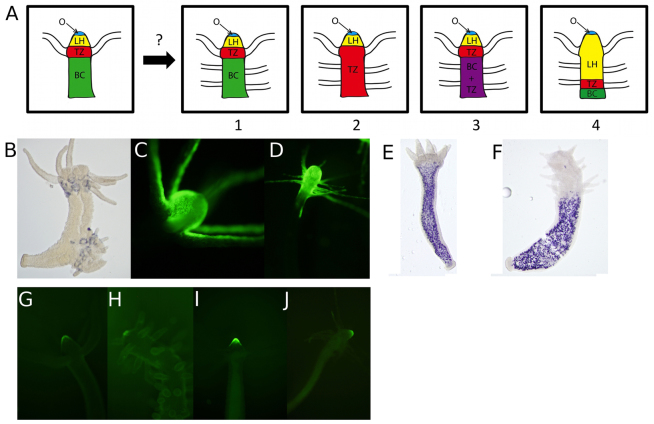Fig. 5.
Markers of positional identity show conversion of body column to tentacle zone upon chronic treatment with DAC-2-25. (A) Four models to explain the identity of the tissue containing ectopic tentacles produced in response to DAC-2-25. (Far left) An untreated Hydra has four tissue identities associated with the head and upper body column: O, organizer; LH, lower hypostome; TZ, tentacle zone; BC, body column. We hypothesized that: (1) ectopic tentacles could form within tissue that has retained body column identity; (2) ectopic tentacles could arise within tissue that has been transformed into tentacle zone; (3) ectopic tentacles could arise in tissue that has both body column and tentacle zone identities; or (4) that the lower hypostome expands, pushing the tentacle zone down the body column, while previously formed tentacles are maintained. (B) In situ hybridization for HyAlx in a polyp treated for 11 days; ectopic tentacles have rings of HyAlx expression in their ectoderm, as seen in untreated controls [not shown, described elsewhere (Smith et al., 2000)]. H301p::GFP::H301t, a transgenic line in which the Hym-301 promoter drives GFP expression in the ectoderm (C), after 27 days of exposure to DAC-2-25 (D), the zone of GFP expression has expanded. (E) An in situ hybridization for a body column-specific gene in an untreated animal and after 23 days of exposure to DAC-2-25 (F). The transgenic line Ec(HyWnt3FL::GFP) created by Nakamura et al. (Nakamura et al., 2011), in which the Wnt3 promoter drives expression of GFP in the ectoderm (G). (H) The region of GFP expression in ec(HyWnt3FL::GFP) did not expand upon exposure to DAC-2-25. The expression pattern of GFP in a transgenic reporter for HyBra2 in the ectoderm (I) does not change in response to DAC-2-25 (J).

